Attached files
| file | filename |
|---|---|
| 8-K - 8-K - Kala Pharmaceuticals, Inc. | a18-2381_18k.htm |
Disclaimers and Notices This presentation contains forward-looking statements within the meaning of the Private Securities Litigation Reform Act of 1995, that involve substantial risks and uncertainties including statements regarding the development and regulatory status of the company's product candidates, including INVELTYSTM (KPI-121 1.0%) for the treatment of inflammation and pain following ocular surgery and KPI-121 0.25% for the temporary relief of the signs and symptoms of dry eye disease. All statements, other than statements of historical facts, contained in this presentation, including statements regarding our strategy, future operations, future financial position, future revenue, projected costs, prospects, plans and objectives of management, are forward-looking statements. The words “anticipate,” “believe,” “estimate,” “expect,” “intend,” “may,” “plan,” “predict,” “project,” “target,” “potential,” “will,” “would,” “could,” “should,” “continue” and similar expressions are intended to identify forward-looking statements, although not all forward-looking statements contain these identifying words. We may not actually achieve the plans, intentions or expectations disclosed in our forward-looking statements, and you should not place undue reliance on our forward-looking statements. Actual results or events could differ materially from the plans, intentions and expectations disclosed in the forward-looking statements as a result of various risks and uncertainties including, but not limited to: whether the data from our Phase 3 clinical trials of KPI-121 0.25% will warrant submission of an NDA on the timeline expected, or at all, whether any additional clinical trials will be required prior to submission of an NDA and whether any such NDA will be approved; that topline data is based on preliminary analysis of key efficacy and safety data, and such data could change following a more comprehensive review and may not accurately reflect the complete results of our clinical trials; whether our NDA for INVELTYS will be approved by its PDUFA date or at all; uncertainties inherent in the availability and timing of data from ongoing clinical trials; expectations for regulatory approvals to conduct trials or to market products; whether the Company’s cash resources will be sufficient to fund the Company’s foreseeable and unforeseeable operating expenses and capital expenditure requirements; the risk that our audited financial results for the year ended December 31, 2017, including cash on hand, may differ materially from our estimated results for these periods as a result of the completion of year-end closing procedures, other matters that could affect the availability or commercial potential of the Company’s product candidates; and other important factors, any of which could cause the Company’s actual results to differ from those contained in the forward-looking statements, discussed in the “Risk Factors” section of the Company’s most recently filed Quarterly Report on Form 10-Q and other filings the Company makes with the Securities and Exchange Commission. All information in this presentation is as of January 8th, 2018, and should not be considered current after such date. We do not assume any obligation to update any forward-looking statements, whether as a result of new information, future events or otherwise, except as required by law. 2
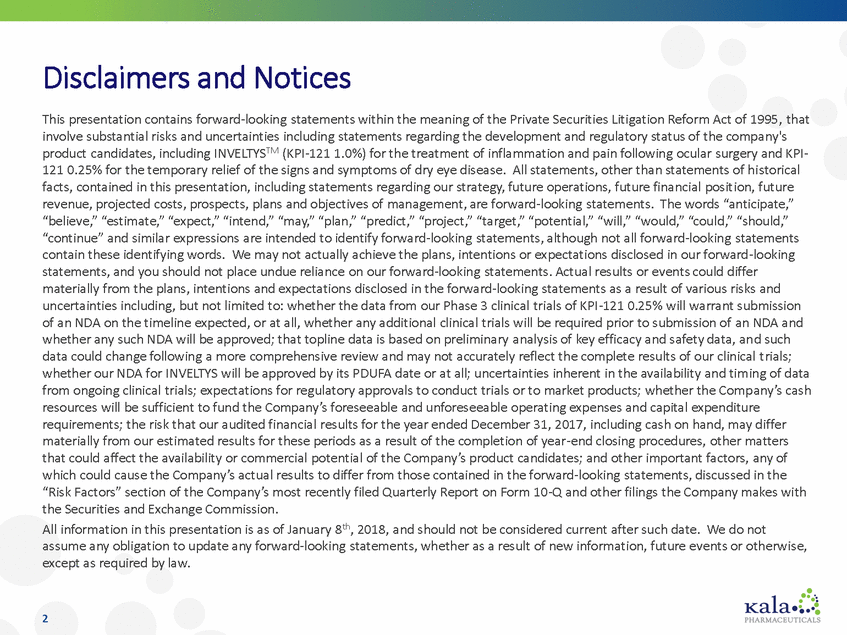
Experienced Leadership Team Mark Iwicki: CEO, Chairman of the Board Previous: CEO Civitas Therapeutics; CEO Blend Therapeutics; CEO Sunovion Pharmaceuticals; Novartis; Merck Todd Bazemore: Chief Operating Officer Previous: EVP & COO Santhera Pharmaceuticals; EVP & CCO Dyax Corp; Sunovion Michele LaRussa: SVP, Regulatory Affairs and Quality Assurance Previous: Global Head of Regulatory Affairs, Dermatology, GSK; Allergan Kim Brazzell, PhD: Chief Medical Officer Previous: CMO/Head Ophthalmology Business, Inspire Pharmaceuticals; Head R&D, Novartis Ophthalmics Vin Kosewski: SVP, Manufacturing and Supply Chain Previous: VP Supply Chain Ops, Sunovion; Sepracor; Astra USA Hongming Chen, ScD: Chief Scientific Officer Previous: TransForm Pharmaceuticals (J&J), AstraZeneca; Merck; MIT ScD Mary Reumuth, CPA: Chief Financial Officer Previous: Corporate Controller, Enobia Pharma; Genzyme; Ernst & Young LLP 3

Key Highlights (MPP) technology to enhance candidates in the US with our own 4 Expect to commercialize product focused, specialty sales force Topline results for Dry Eye Disease Phase 3 trials announced in Jan 2018 INVELTYSTM NDA (Post-surgery product) submitted to FDA in Oct 2017; PDUFA action date of Aug 24, 2018 Retained worldwide commercial rights for our current product candidates Mucus-penetrating nanoparticle delivery to target tissues of the eye IP protection for MPP technology and products through 2033
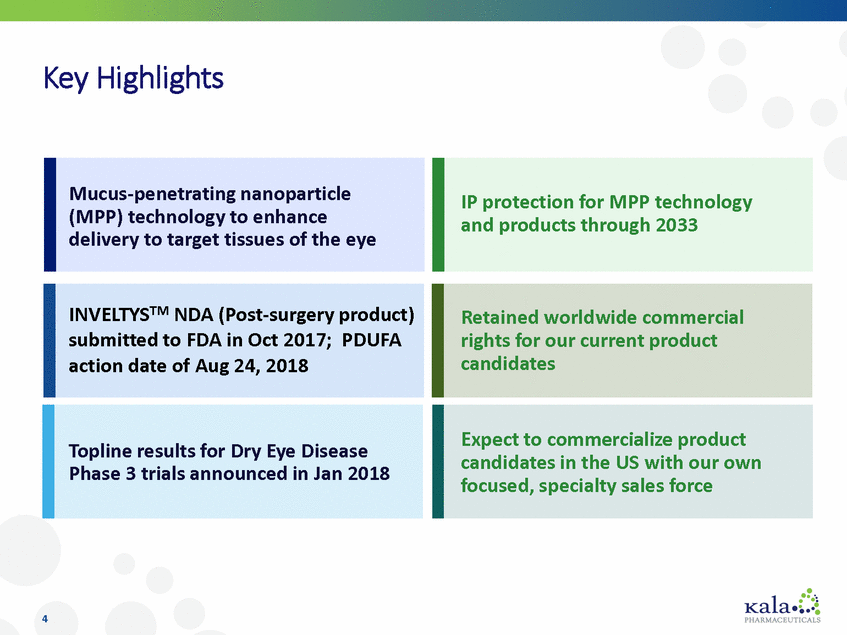
Two Product Candidates in Late Stage Development • • Potential first FDA-approved topical steroid with BID dosing for treatment of inflammation and pain following ocular surgery ~7.7M ocular surgeries performed in the U.S. in 2016 with ~9.4M annual ocular surgeries projected for 2021 Phase 3 complete; statistical significance achieved for both primary endpoints for both Phase 3 trials NDA submitted to FDA in October 2017 PDUFA date: Aug 24, 2018 ~33M dry eye sufferers in U.S. of which ~16M are diagnosed patients Potential first-line Rx therapy in dry eye disease May be complementary to chronic maintenance therapies Two Phase 3 trials completed: • • • • • o Statistical significance for primary sign and primary symptom endpoint in STRIDE 1 Statistical significance for primary sign endpoint in STRIDE 2 • • o Source for ocular surgery market data: Market Scope Source for dry eye disease market data: Epidemiology research commissioned by Kala and performed by a third party 5 KPI-121 0.25%: For Dry Eye Disease INVELTYSTM (KPI-121 1%): For Post-Surgical Inflammation and Pain
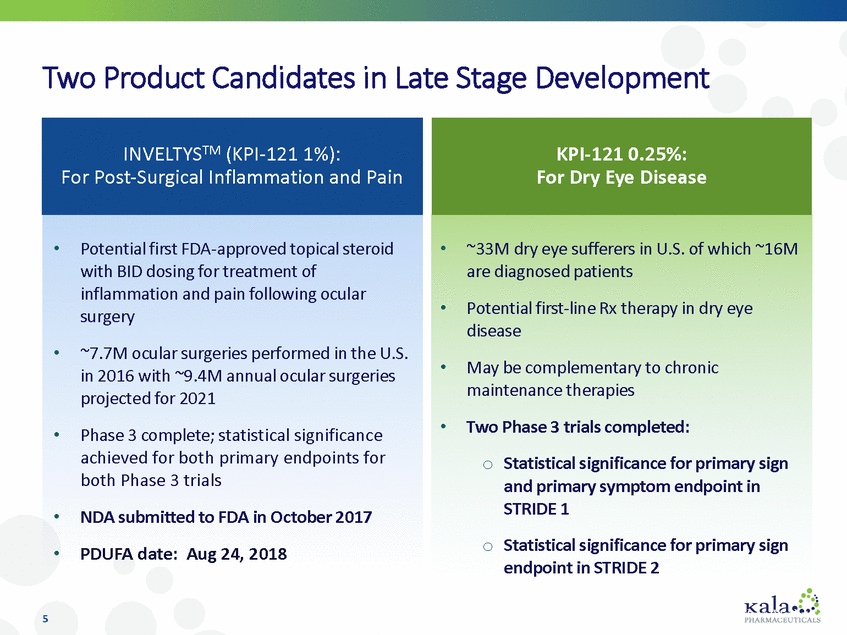
Mucus Penetrating Nanoparticle (MPP) Technology Overview
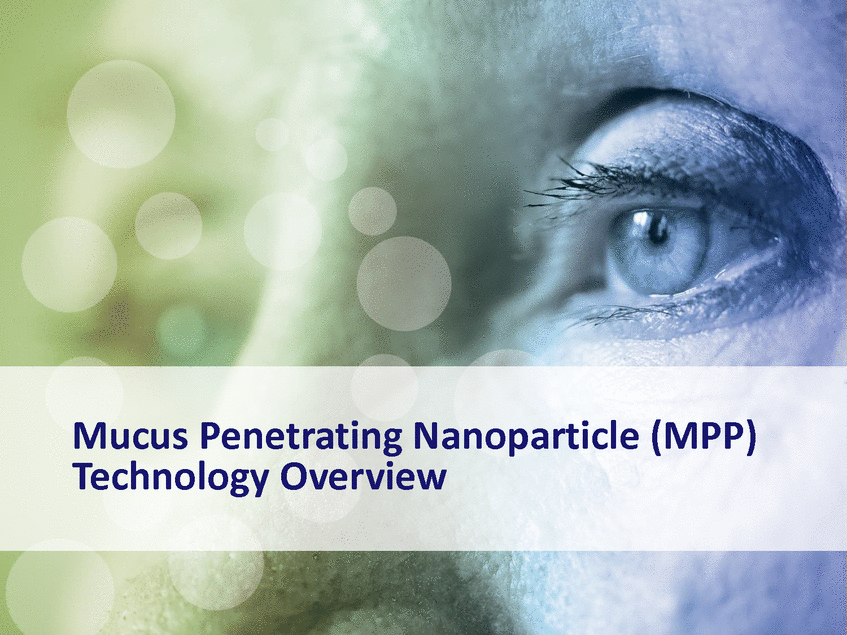
In the Eye, MPPs Penetrate Through Tear Film Mucins Enhance Drug Delivery to Target Ocular Tissues to Traditional Suspension Eye Drop Kala MPPs Tear (soluble) mucins Tear Film Clearance Membrane-bound mucins Cornea Traditional suspension eye drops adhere to the mucins and are rapidly cleared with the tears via blinking MPPs move freely through tear mucins into the membrane-bound mucins, allowing increased penetration and more even coating of target tissues 7 Increased Penetration

MPPs Enable Corneal Delivery and Duration Non-coated nanoparticles are trapped by tear mucins and rapidly eliminated from ocular surface via blinking Control Nanoparticles 1 dose 2 hours 4 hours MPP-coated non-dissolving nanoparticles are not trapped by tear mucins. They settle into membrane-bound mucins and penetrate to underlying corneal epithelial tissues Kala MPPs MPPs – inert nanoparticles with Kala’s proprietary coating Control nanoparticles - same size and composition as the MPPs but without the proprietary coating 8 Source: Kala data
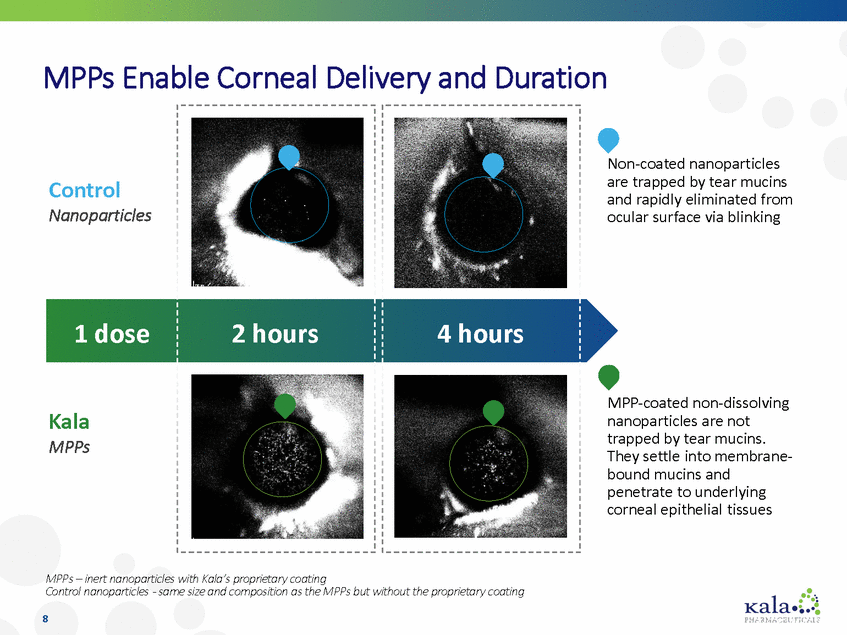
We Believe MPP Technology and Efficacy Can Enhance Drug Delivery • MPP surface modification avoids MPP Technology mucus clearance higher target tissue delivery and more uniform coverage enhanced + pharmacokinetics (PK) and efficacy MPP’s nano-size drives high drug dissolution and thereby enhances tissue penetration Both attributes critical: - Large particles cannot permeate the mucus barrier - Conventional nanoparticles without MPP coating have not resulted in enhanced PK Increases penetration of drug into ocular tissues Improves distribution of drug within the ocular tissues • • IP Protection for MPP Technology and Products Through 2033 9 Which enables: Enhanced efficacy at equal or even lower doses Less frequent dosing for improved patient convenience and compliance
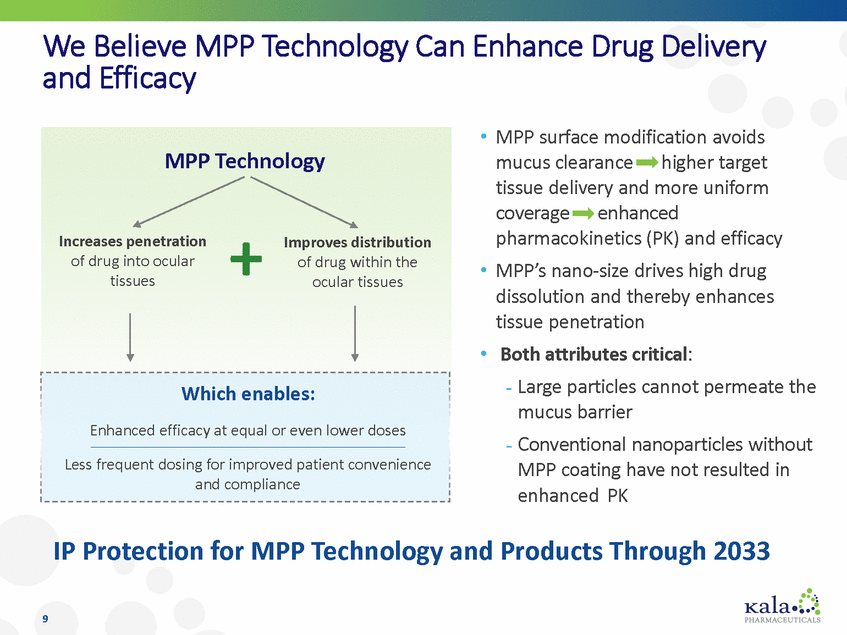
Loteprednol Etabonate (LE) Is A Potent Steroid With Improved Safety Characteristics Effect on IOP in steroid responsive patients (LE vs prednisolone (PA)) • Ester steroid differing from traditional ketone-based steroids (such as prednisolone and dexamethasone) by its metabolism to inactive metabolites • 4.3X greater glucocorticoid receptor (GR) binding affinity versus dexamethasone Therapeutic effect followed by predictable single-step deesterification to inactive carboxylic acid metabolites • • Enhanced safety relative to ketone steroids Inactive carboxylic metabolite Loteprednol etabonate (active) D1-cortienic acid (inactive) LE Loteprednol etabonte M-COOH LE, 17b-acid metabolite (D1-cortienic acid etabonate) (inactive) Sources: Comstock and DeCory, Int J Inflamm 2011; Bartlett et al, J Ocul Pharm 1993 10
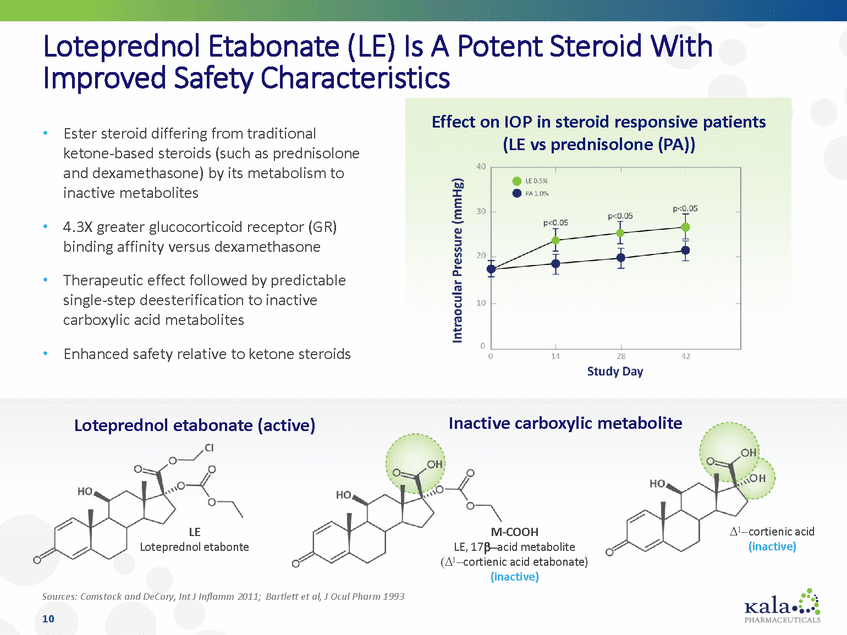
Leveraging LE-MPP to Enhance Tissues Delivery to Target Ocular • KPI-121: MPP loteprednol etabonate (LE) LE in Aqueous Humor - INVELTYSTM (KPI-121 1%): Product Candidate for Post-Surgical Pain and Inflammation KPI-121 0.25%: Product Candidate for Dry Eye Disease - • MPP increases LE penetration to corneal and aqueous humor by more than 3X • Aqueous Humor concentrations mediate resolution of inflammation following ocular surgery LE in Cornea • Corneal deposition is a key driver for Dry Eye efficacy and resolution of pain following ocular surgery Preclinical data from rabbit studies 11

Kala Late Stage Programs
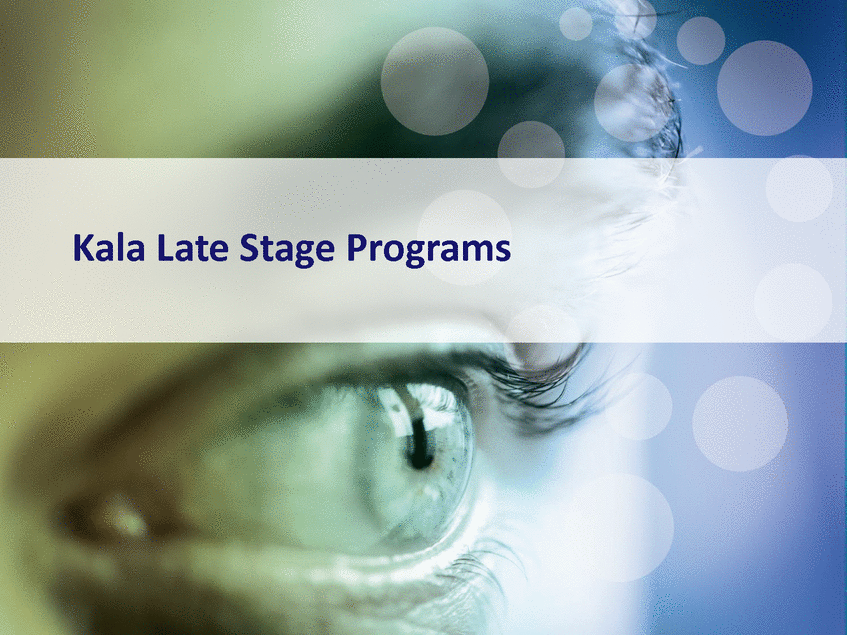
Late Stage Programs in Dry Eye Disease and Post Surgical Inflammation and Pain INVELTYSTM (KPI-121 1%): Potential First Approved Product With BID Dosing For Treatment Of Inflammation And Pain Following Ocular Surgery Positive Confirmatory Phase 3 Trials Completed Positive Phase 3 Trial Completed NDA Submitted Oct 2017 KPI-121 0.25%: Potential First Approved Product For The Temporary Relief Of Signs & Symptoms Of Dry Eye Disease – 2 Week Course of Therapy Topline Results Announced Jan 2018 Positive Phase 2 trial Completed Two Phase 3 Trials Completed 13
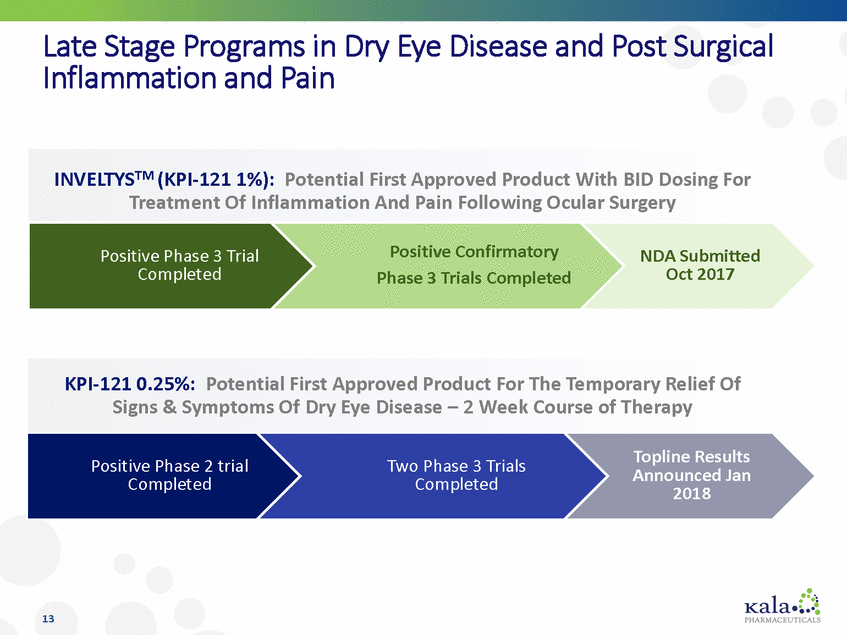
INVELTYSTM for Post-Surgical Inflammation and Pain
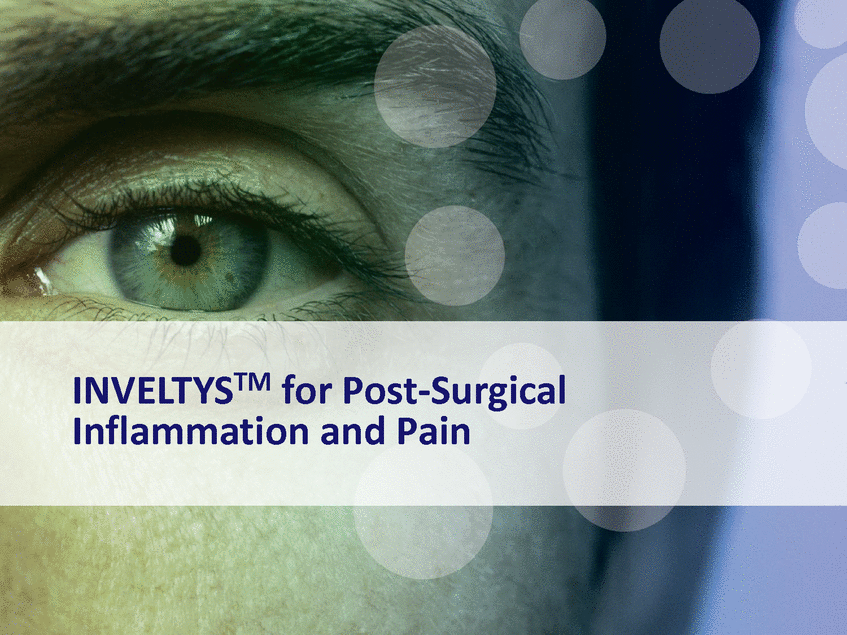
Treatment of Inflammation & Pain Following Ocular Surgery • ~7.7M ocular surgeries performed in the U.S. in 2016 with ~9.4M annual ocular surgeries projected for 2021 - ~3.9M cataract surgeries in the U.S. in 2016, projected to grow to ~4.6M in 2021 • Topical corticosteroids are the current standard of care for treatment of inflammation & pain after cataract and other ocular surgeries Current topical steroids are approved for QID dosing, which can lead to compliance issues for patients An effective topical steroid with BID dosing would be a significant benefit in the management of patients following ocular surgery Typical Current Post-Operative Treatment Regimen • • Typically 4x/day Typically Typically 1-3x/day 15 NSAID Steroid Antibiotic
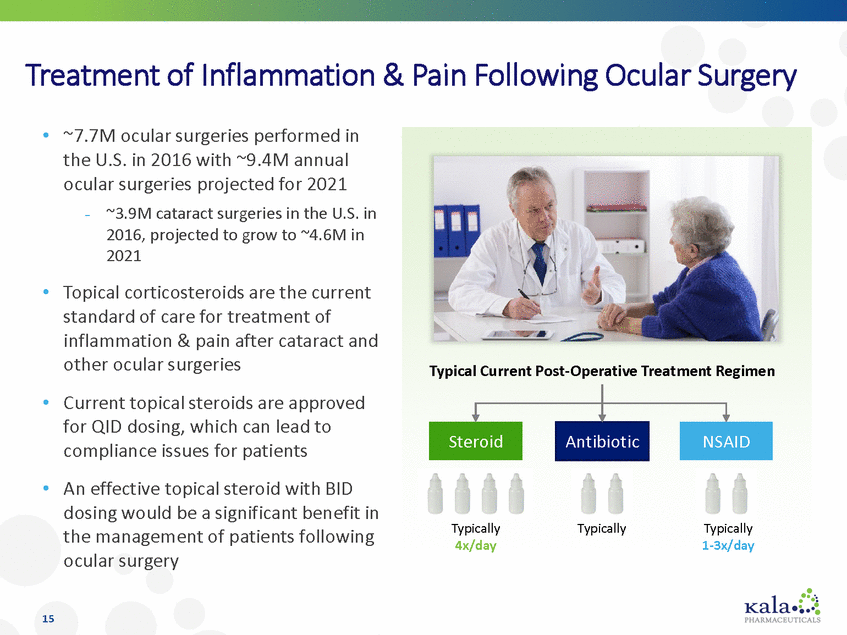
Statistical Significance for Phase 3 Trials Both Primary Endpoints in First Phase 3 Trial (001 Study) Second Phase 3 Trial (005 Study) • • Standard clinical design utilized for all post-surgical steroids Two-week dosing in patients with intraocular inflammation one day after cataract surgery (N=380 in 001 Study, N=520 in 005 Study) Primary endpoints: • - Proportion of patients with complete resolution of anterior chamber cells at post-operative Day 8 maintained through end of study with no need for rescue medication Proportion of patients with complete resolution of pain (grade = 0) at post-operative Day 8 maintained through end of study with no need for rescue medication - 16
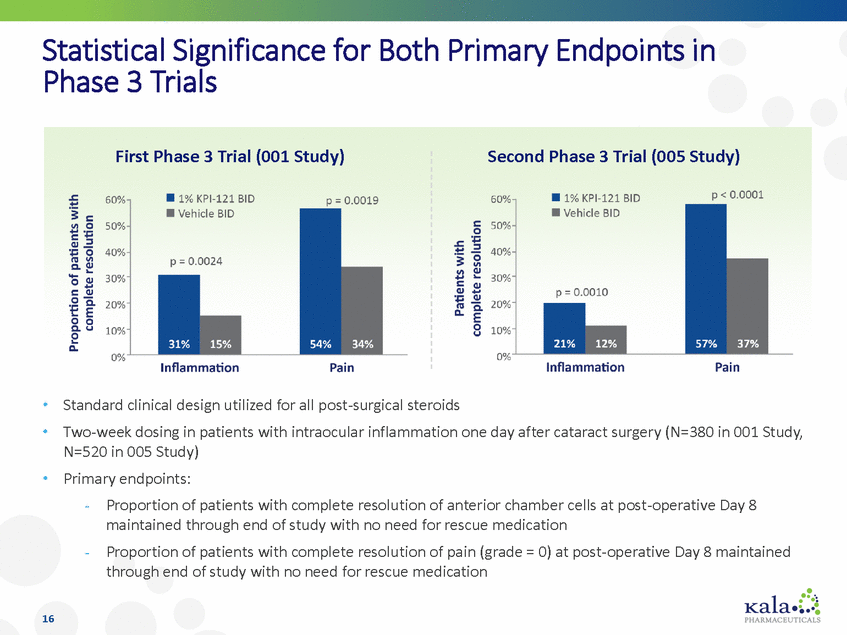
Statistical Significance for Secondary Endpoints in Study #005 Proportion of Patients with Complete Resolution of Pain at Day 4 Proportion of Patients with Complete Resolution of Flare at Day 4 Mean Change in Cell Count at Day 4 43% 42% 24% 25% -0.5 -0.7 17
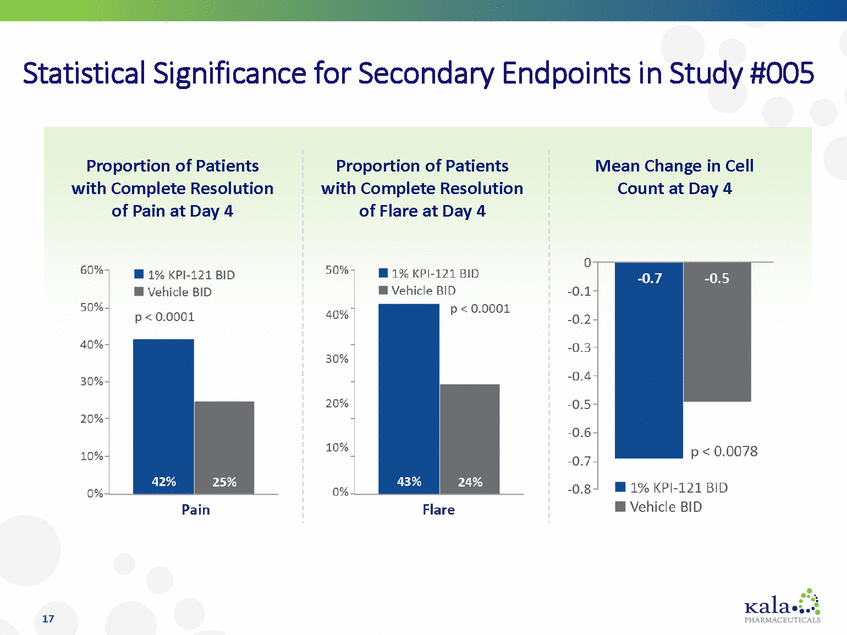
005 Study: Similar Effect on Intraocular Pressure (IOP) for INVELTYS vs Placebo Mean IOP (Safety Population) Mean (SD) in mmHg (n=259) Number of Patients with IOP Increase > 5 mmHg Leading to IOP > 21 mmHg (Safety Population) 18 INVELTYS – BID Vehicle Day 8 0 (0.0%) n=240 1 (0.5%), n=204 Day 15 0 (0.0%) n=212 0 (0.0%), n=159 INVELTYS – BID Mean (SD) in mmHg (n=261) Vehicle Day 1 15.7 (3.37) 15.6 (2.96) Day 8 14.3 (3.02) 13.5 (3.10) Day 15 14.5 (2.77) 14.2 (2.96)
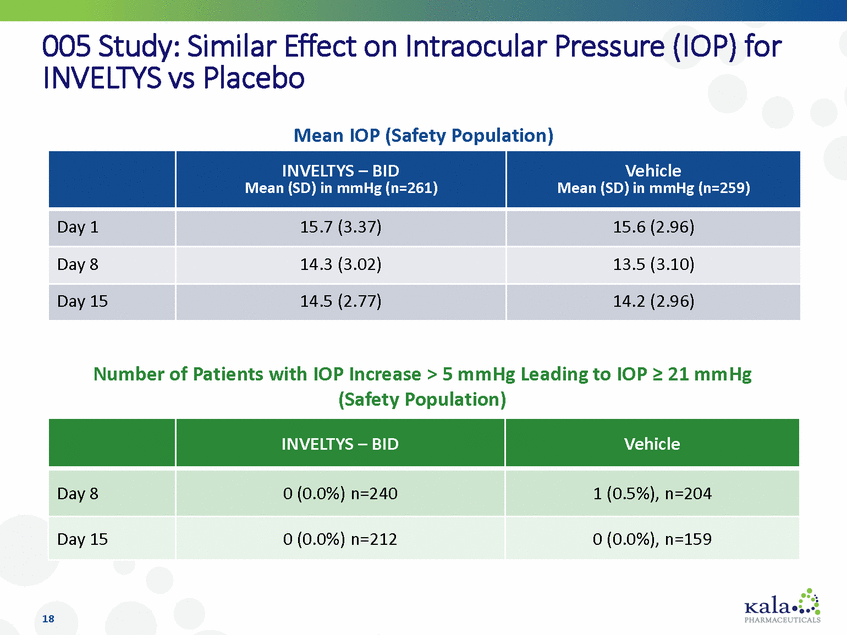
INVELTYS PDUFA Target Action Date of August 24, 2018 • Statistical significance achieved for all primary endpoints in both Phase 3 trials • AE profile comparable to placebo - Most common AEs in INVELTYS arm only seen in 1.6% and 1.1% of patients in 001 and 005 studies • Comparable IOP profiles between INVELTYS and placebo • NDA submitted to FDA in October 2017; PDUFA target date of August 24th, 2018 • Expect to commercialize with sales force of approximately 75 representatives 19
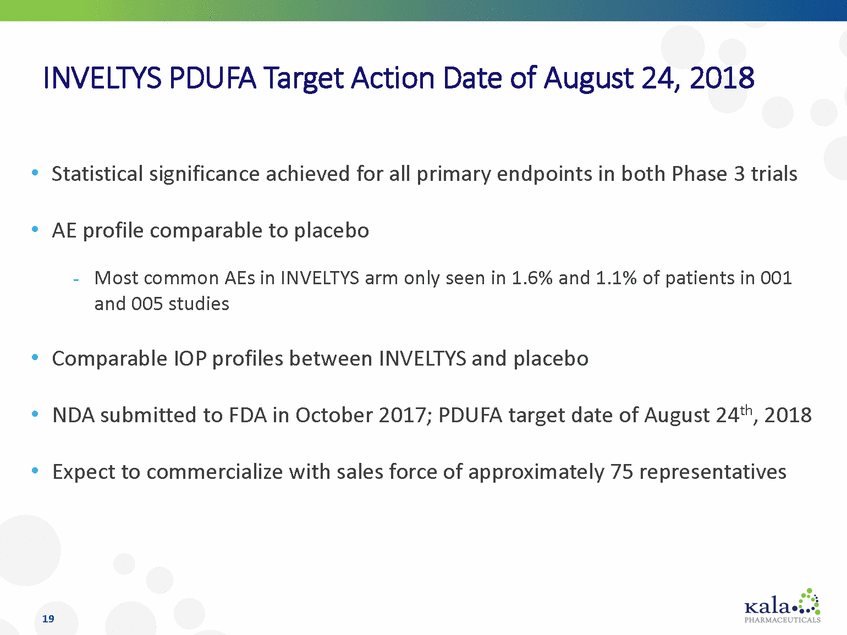
KPI-121 0.25% for Dry Eye Disease
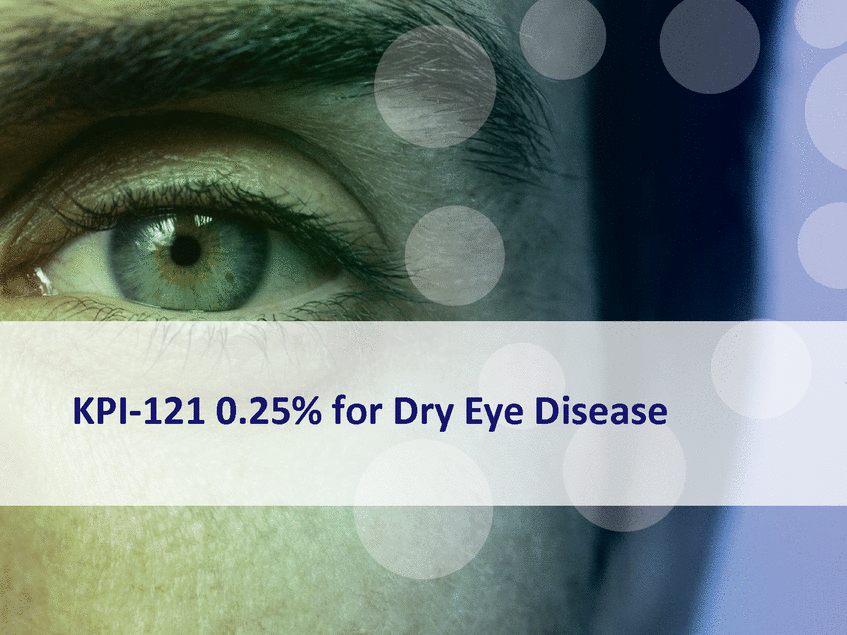
Dry Eye Is An Inflammation Driven Disease • Dry eye disease is a chronic, episodic disease of ocular inflammation ~33 million people in the US with dry eye disease of which ~16M are diagnosed patients For most patients, dry eye symptoms are episodic, not continual Breaking The Dry Eye Cycle Controlling Inflammation is the Key To Effective Management Of Dry Eye • Cornea / Conjunctiva Damage Tear Film Instability • - For these patients, chronic therapy may not be necessary or appropriate • Currently there is no approved product for the short-term rapid relief of episodic symptoms - Restasis and Xiidra are typically used as maintenance therapy for patients who have continuous symptoms These products have relatively long onset of action and therefore are generally not used for the short-term treatment of episodic flares Tear Hyperosmolarity Ocular Surface Inflammation - KPI-121 0.25% 21
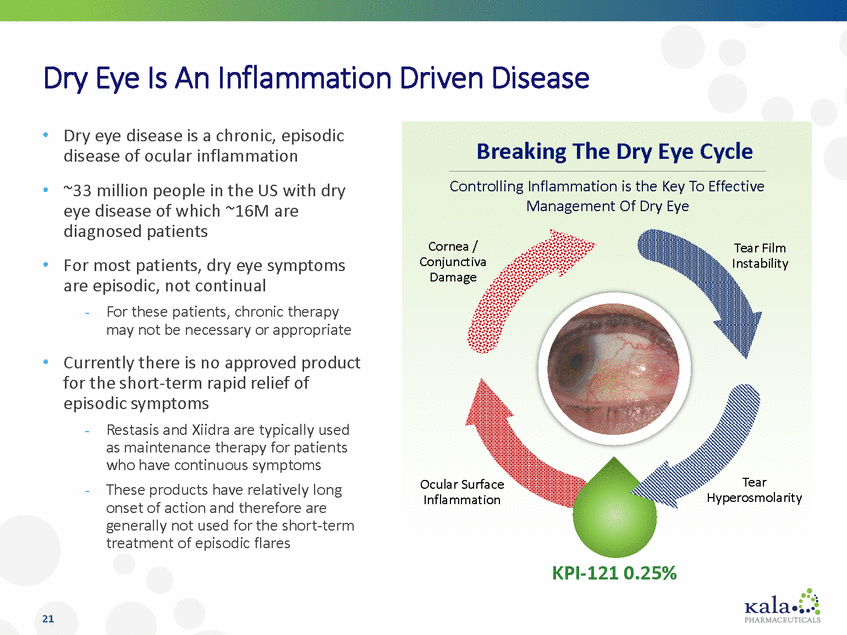
Dry Eye Is A Chronic…Yet Episodic Disease ~90% of surveyed dry eye patients experience flares and the majority have multi-day episodes • Patients have symptom “flares” that wax and wane in response to environmental triggers Flares are seen across the spectrum of severity levels Flares can become more frequent and problematic as the disease progresses KPI-121 0.25% can be used as a two-week course in combination with baseline therapies • • Spring Allergy Season Summer A/C use Environmental Triggers Fall Allergy Season Cold Dry Winter • Work & Home Episodic Flare Drivers This graphic is included for illustrative purposes only Based on a survey of 30 patients diagnosed with dry eye disease commissioned by Kala and performed by a third party. 22 Severity of Flare Episode Patient flares No Rx treatment approved
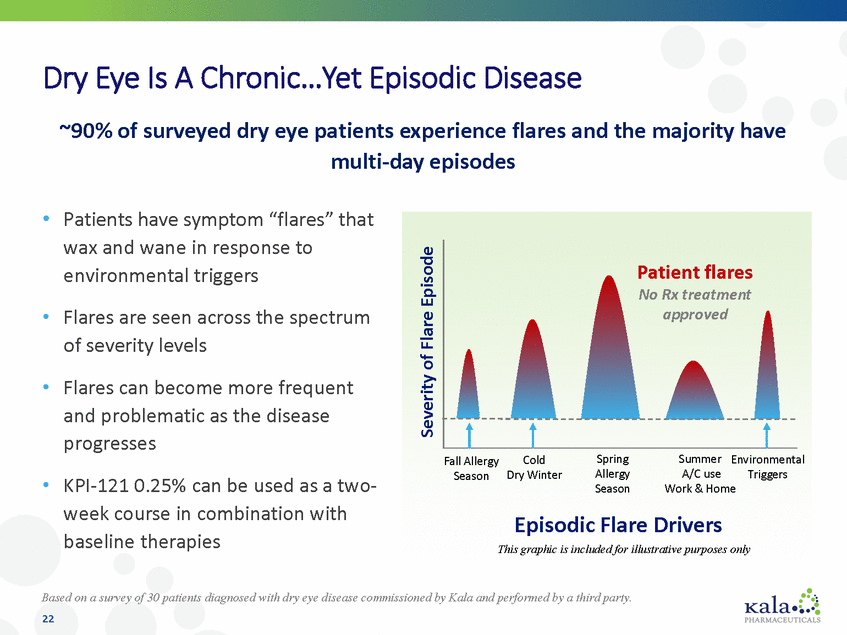
Robust Improvement in Primary Sign Endpoint and Strong Trend in Symptom Endpoint in Phase 2 Conjunctival Hyperemia - ITT Ocular Discomfort - ITT KPI-121 (n=72) Vehicle (n=77) 70 KPI-121 0.25% (n=73) Vehicle (n=77) 2.5 65 2 p = 0.0090 60 1.5 55 1 Da2y 15 Base1line 23 Bulbar Conjunctival Hyperemia Score` Ocular Discomfort Score (mm) Base1 line Da2y 15 Δ= -0.26 Δ= -5.01 p = 0.062

Phase 2 Results: Effect of KPI-121 0.25% on IOP Mean IOP (Safety Population) Mean (SD) in mmHg (n=78) Number of Patients with IOP Increase > 5 mmHg Leading to IOP > 21 mmHg (Safety Population) 24 KPI-121 0.25% QID Vehicle Day 15 1 (1.4%), n=72 1 (1.3%) n=78 Day 29 1 (1.4%), n=72 0 (0.0%) n=78 KPI-121 0.25% QID Mean (SD) in mmHg (n=72) Vehicle Day 1 14.8 (2.33) 14.8 (2.61) Day 15 15.3 (2.66) 15.3 (2.73) Day 29 15.6 (3.12) 15.1 (2.80)

Two Phase 3 Clinical Trials Completed (STRIDE 1 & STRIDE 2) Placebo (vehicle) QID Qualification Re-qualification Day 15: Study Assessments Day 1: Randomization Daily Symptom Diary 25 Study Design (each trial) Study Population • 900+ subjects with diagnosed DED (918 randomized in STRIDE 1; 909 randomized in STRIDE 2) Key inclusion criteria • Investigator-rated bulbar conjunctival hyperemia of > 2 both before and after placebo run-in • Score of > 50 mm ocular discomfort before placebo run-in AND > 40 mm after run-in • Corneal fluorescein staining score > 6 (out of possible 15) both before and after placebo run-in • Schirmer score < 10 mm both before and after placebo run-in Treatment • Two week run-in with placebo QID after qualification • Two week randomized treatment with KPI-121 0.25% QID vs Placebo QID after re-qualification KPI-121 vehicle QID for 2 Weeks 2 week run-in KPI-121 0.25% QID for 2 weeks
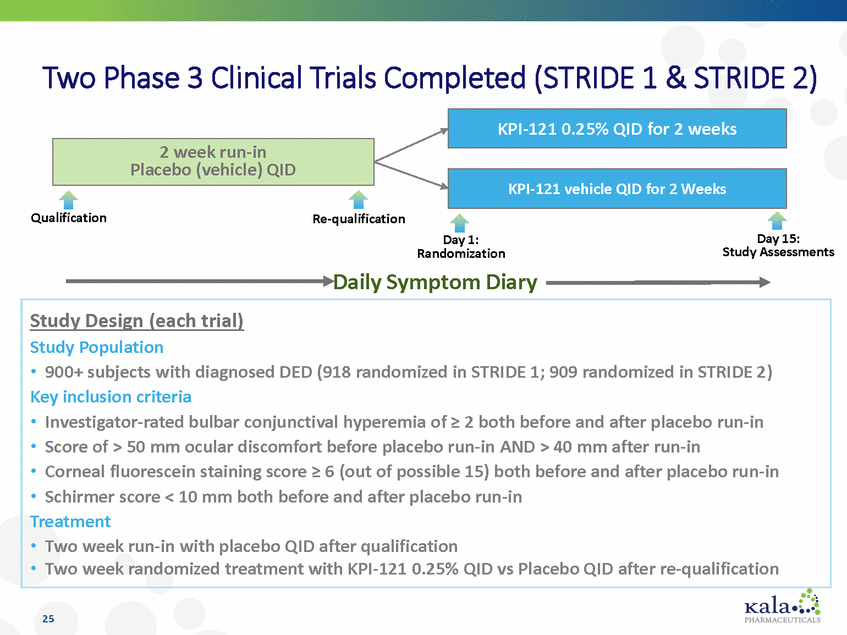
Statistically Significant Improvements in Conjunctival Hyperemia in Both Phase 3 Trials STRIDE 1: Mean Conjunctival Hyperemia - ITT Primary Sign Endpoint STRIDE 2: Mean Conjunctival Hyperemia - ITT Primary Sign Endpoint 2 2 1.5 1.5 1 1 Baseline KPI-121 0.25% (n = 458) Day 15 Vehicle (n=455) Baseline KPI-121 0.25% (n = 452) Day 15 Vehicle (n=453) 26 Conjunctival Hyperemia Score Conjunctival Hyperemia Score Statistical significance achieved for primary sign endpoint in both STRIDE 1 and STRIDE 2 p<0.0001 p<0.0001

Statistically Significant Improvements in Ocular Discomfort in STRIDE 1 STRIDE 1 Ocular Discomfort Severity - ITT STRIDE 2 Ocular Discomfort Severity - ITT KPI-121 0.25% (n = 459) KPI-121 0.25% (n = 452) Vehicle (n=456) Vehicle (n=453) 70 70 Key Secondary Key Secondary Endpoint Symptom p=0.0408 Endpoint 60 60 50 50 Baseline Day 8 Day 15 Baseline Day 8 Day 15 27 Ocular Discomfort Severity Score (mm) Ocular Discomfort Severity Score (mm) Statistical significance for primary symptom endpoint achieved in STRIDE 1 but not STRIDE 2 Symptom Primary p=0.0011Endpoint P<0.0001 Symptom Endpoint Primary Symptom p=0.1298
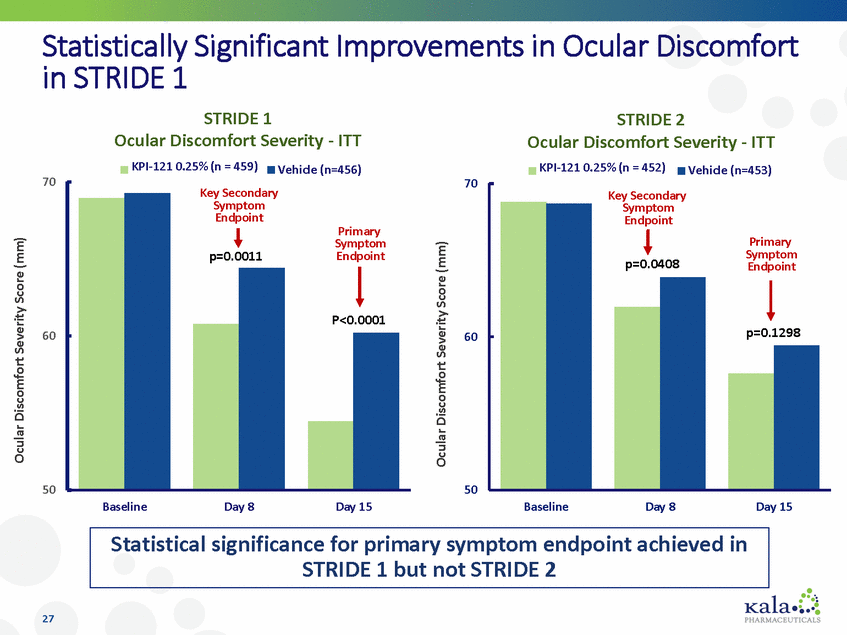
Statistical Significant Improvements in Ocular Discomfort in Patients with More Severe Baseline Discomfort in STRIDE 1 STRIDE 2 STRIDE 1 Ocular Discomfort Severity in Patients with Baseline Discomfort > 68 mm Ocular Discomfort Severity in Patients with Baseline Discomfort > 68 mm KPI-121 0.25% (n = 260) KPI-121 0.25% (n = 254) Vehicle (n=263) Vehicle (n=256) 80 80 Symptom p=0.2005 70 70 60 60 Baseline Day 8 Day 15 Baseline Day 8 Day 15 28 Ocular Discomfort Severity Score (mm) Ocular Discomfort Severity Score (mm) Statistical significance achieved for second predefined primary symptom endpoint in STRIDE 1 but not for key secondary symptom endpoint in STRIDE 2 Primary p=0.0156Endpoint p=0.0008 Key Secondary Symptom Endpoint p=0.0799
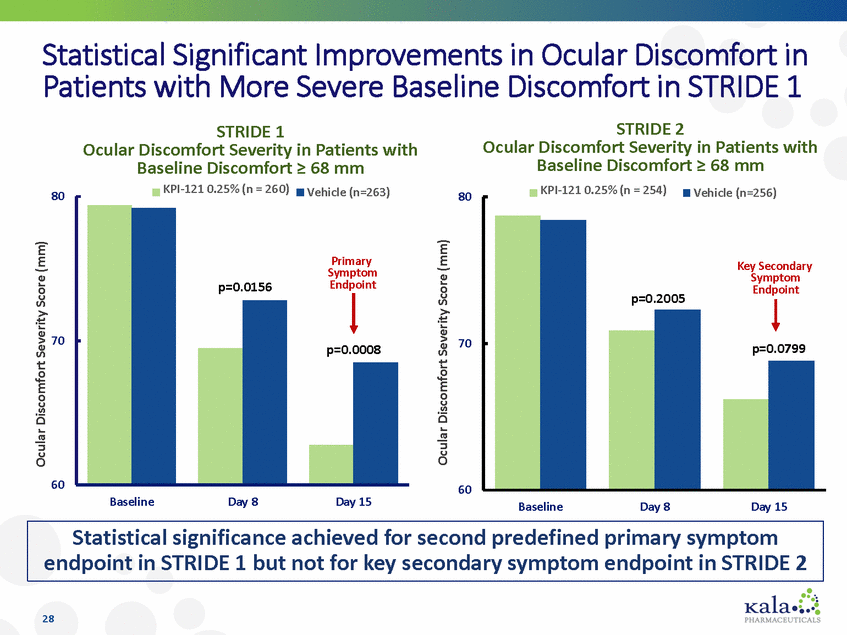
KPI-121 0.25% Was Well-Tolerated in Both AEs Reported by >1% of patients STRIDE 1 and 2 STRIDE 1 pain (6.1%) (6.1%) (1.1%) (1.5%) STRIDE 2 pain (5.7%) (4.4%) (0.2%) (1.3%) 29 KPI-121 0.25%Vehicle Instillation site26/45320/452 Vision blurred1/4536/452 KPI-121 0.25%Vehicle Instillation site28/45928/456 Eye irritation5/4597/456
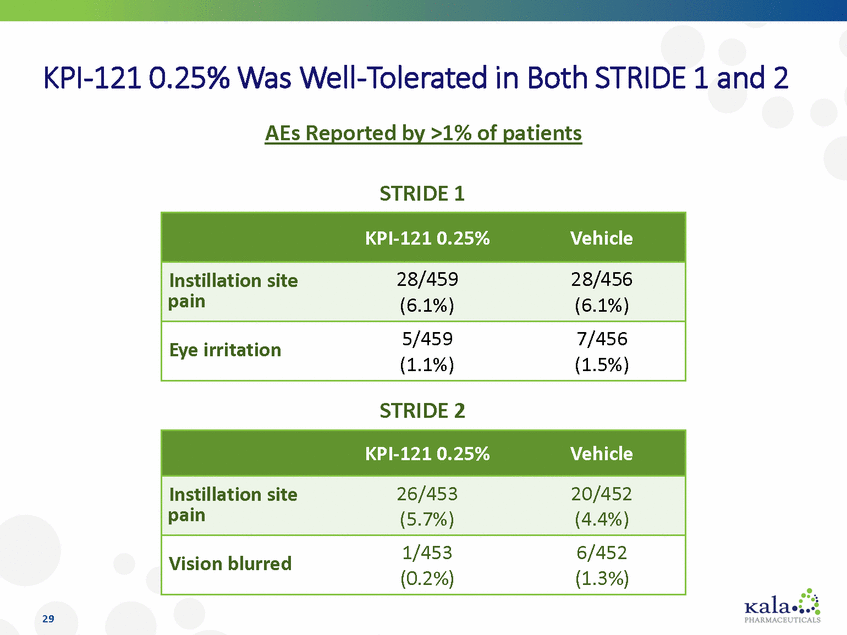
KPI-121 0.25% Demonstrated Similar in Both Trials IOP Profile to Placebo Mean IOP STRIDE 1 STRIDE 2 Mean (SD) in Number of Patients with IOP Increase > 5 mmHg Leading to IOP > 21 mmHg STRIDE 1 STRIDE 2 COMBINED (0.0%) 30 KPI-121 0.25% Vehicle 7/903 (0.8%) 2/901 KPI-121 0.25% Vehicle 5/448 (1.1%) 0/448 (0.0%) KPI-121 0.25% Vehicle 2/455 (0.4%) 2/453 (0.4%) KPI-121 0.25% Mean (SD) in mmHg (n=72) Vehicle mmHg (n=78) Day 1 14.8 (2.42) 14.7 (2.51) Day 15 15.0 (2.65) 14.6 (2.41) KPI-121 0.25% Mean (SD) in mmHg (n=459) Vehicle Mean (SD) in mmHg (n=456) Day 1 14.9 (2.66) 15.0 (2.51) Day 15 15.1 (2.67) 14.9 (2.68)
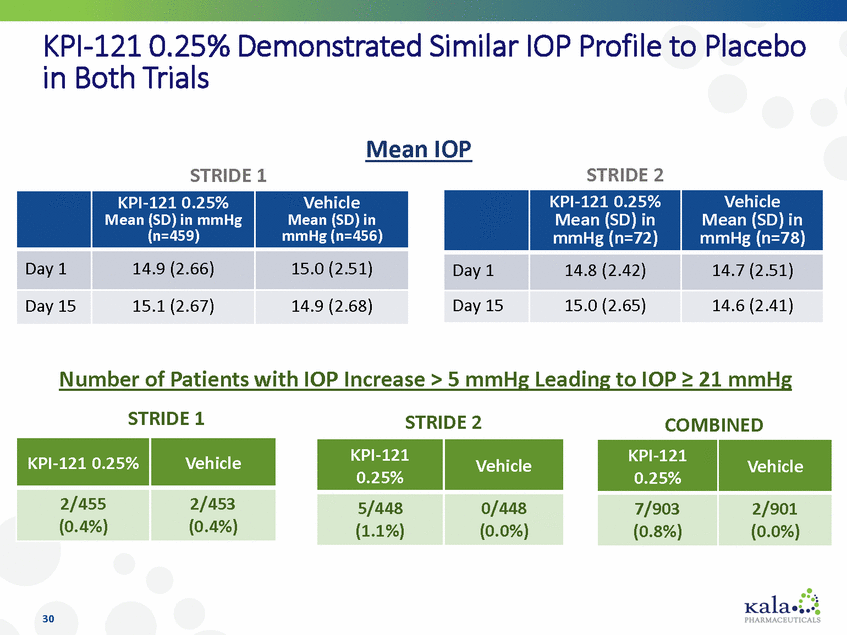
90% of Surveyed Dry Eye Patients Experience Flares Sufferers On Average Have ~9 Flares Per Year, Each Lasting ~11 Days Flares in the Dry Eye Disease Population OSDI scores than patients noticed more individual made patients more likely to events Based on a survey of 30 patients diagnosed with dry eye disease commissioned by Kala and performed by a third party. 31 Based on a survey of 30 patients diagnosed with dry eye disease commissioned by Kala and performed by a third party. Patients with Flares Average OSDI Score LowerSameHigher Patients with flares were more likely to have higher without flares Number of Symptoms LowerSameHigher Patients with flares either experienced or simply symptoms Time Since Diagnosis ShorterSameLonger A longer time since diagnosis experience and identify flare Key Takeaway Comparison to No Flares Factor Multi Day Flares ~70% Flares Lasting 1 Day or Less ~20% No Flares ~10%
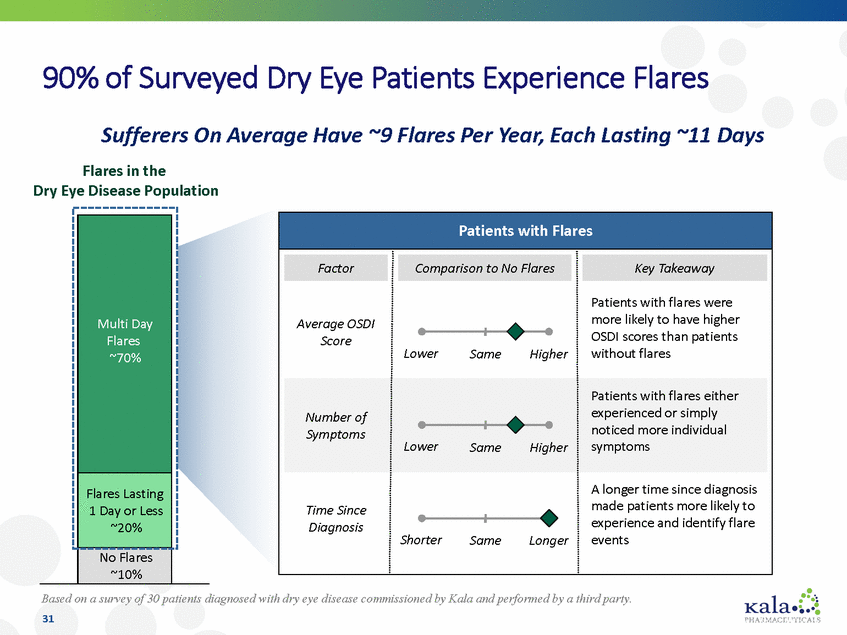
Patient Market Research Suggests Strong Interest in KPI-121 0.25% The majority of surveyed patients expressed interest in the KPI-121 0.25% profile Based on a survey of 30 patients diagnosed with dry eye disease commissioned by Kala and performed by a third party. 32 Based on a survey of 30 patients diagnosed with dry eye disease commissioned by Kala and performed by a third party. • Patients were very interested in the profile and would ask their physicians for more information about KPI-121 0.25% • Patients specifically commented they would like an “as-needed” flare treatment vs. a chronic medicine • The majority of patients indicated they want to try KPI-121 0.25%, expressing high levels of interest • Patients highlighted they want rapid and strong efficacy with a reduction of “redness”, and short-term and “as-needed” flare treatment Interested ~40% Low Interest ~10% High Interest ~50%
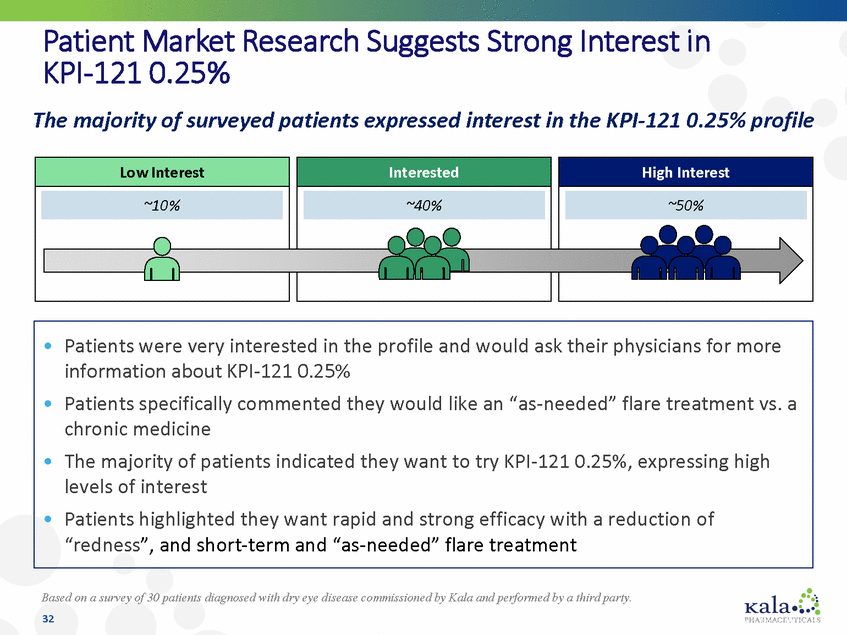
KPI-121 0.25% Is a Potential First Line Rx Therapy in Dry Eye Future Treatment Paradigm Current Treatment Paradigm • • • • • Rapid Onset of Relief Broad Mechanism of Action Well Tolerated Dosing Regimen is Attractive for Treating Episodic Flares May Be Complementary to Chronic Maintenance Therapies 33
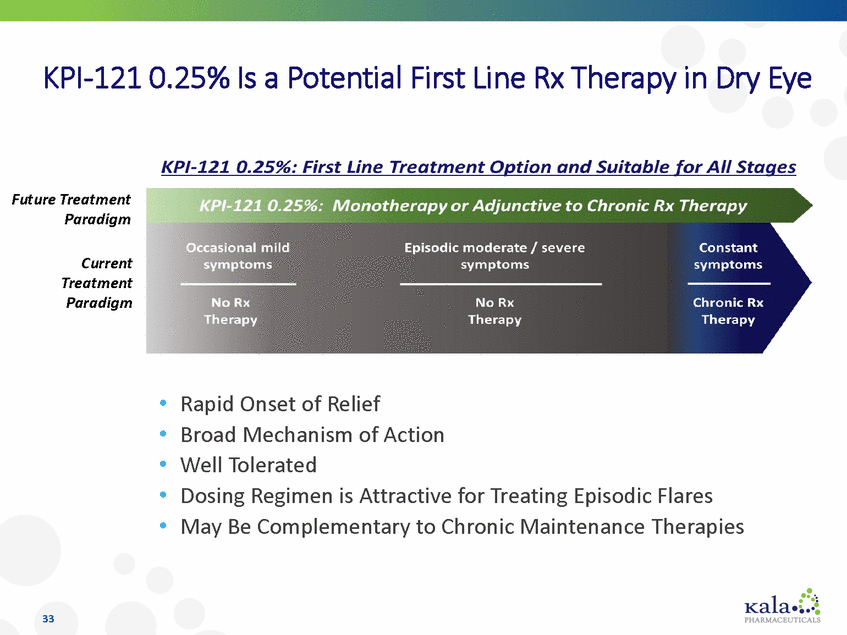
Summary INVELTYSTM: Potential First Twice-daily Ocular Steroid 7.7M ocular surgeries in the US in 2016 with ~9.4M annual ocular surgeries projected for 2021 KPI-121 0.25%: Potential First-Line Rx Therapy to Treat Dry Eye Flares ~33M dry eye sufferers in US Source for ocular surgery market data: Market Scope Source for dry eye disease market data: Epidemiology research commissioned by Kala and performed by a third party 34 MPP Platform Enhances Mobility of Drug Particles Through Mucus Layers INVELTYSTM PDUFA Target Date of August 24th 2017 Topline Results for Dry Eye Phase 3 Trials Announced in Jan 2018
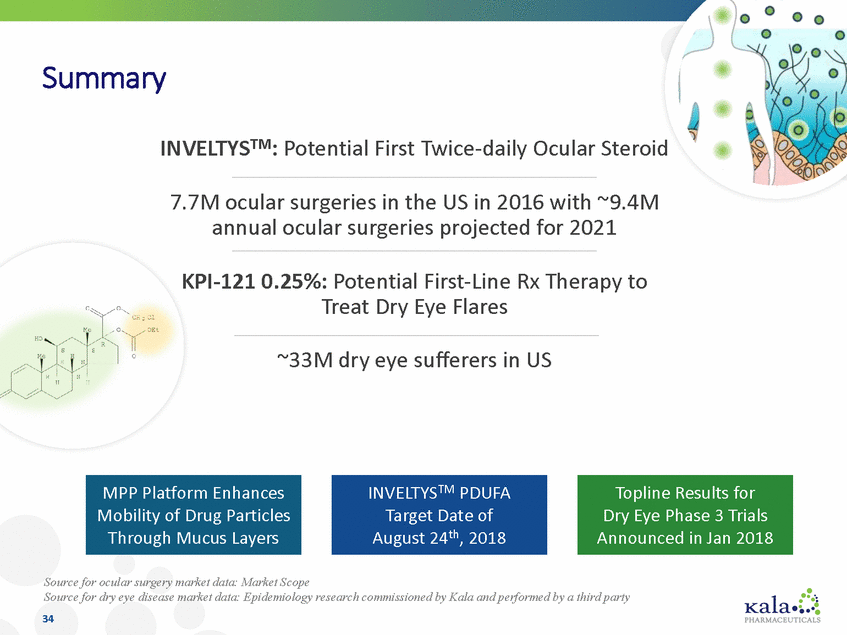
Thank You


